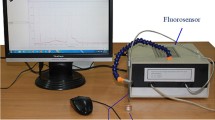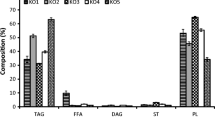Abstract
Chemiluminescence based on light emission from excited oxygen species,e.g. singlet oxygen and triplet carbonyls, has been used to measure the oxidative rencidity of fish oils. The luminescence was recorded after sodium hypochlorite addition to the oils dissolved intert-butanol. In addition to high sensitivity and ability to detect small changes in rancidity, the method is fast and may be used as a supplement to the standard chemical methods for quality assessment and antioxidant evaluation. However, care has to be taken in interpretation of the chemiluminescence data of different fish oils, as the light emission depends on both the composition and the rancidity level of the oil. The autoxidized oils were also characterized by peroxide value, thiobarbituric acid value, anisidine value, Kreis rancidity index, iodine value, ultraviolet measurements, capillary gas chromatography, size-exclusion chromatography and sensoric evaluation.
Similar content being viewed by others
References
Frankel, E.N.,J. Sci. Food Agric. 54:495 (1991).
Hurrell, R.F., and H.K. Nielsen, inLipids in Modern Nutrition, edited by M. Horisberger, and U. Bracco, Vevey/Raven Press, New York, 1987, p. 223.
Kubow, S.,Trends in Food Sci. Technol. 1:67 (1990).
Schnepf, M., G. Spencer and J. Carlat,J. Am. Oil Chem. Soc. 68:281 (1991).
Patterson, H.B.W.,Handling and Storage of Oilseeds, Oils, Fats and Meal, Elsevier Science Publishers, London, 1989.
Robards, K., A.F. Kerr and E. Patsalides,Analyst 113:213 (1988).
Gray, J.I.,J. Am. Oil Chem. Soc. 55:539 (1978).
Rossell, J.B., inRancidity in Foods, 2nd edn., edited by J.C. Allen, and R.J. Hamilton, Elsevier Science Publishers, London, 1989, p. 23.
Yanishlieva, N.,Seifen Öle Fette Wachse 114:356 (1988).
Usuki, R., T. Kaneda, C. Yamagishi, C. Takyu and H. Inaba,J. Food Sci. 44:1573 (1979).
Timms, R.E., and P. Roupas,Lebens. Wiss. Technol. 15:372 (1982).
Cash, G.A., G.A. George and J.P. Bartley,J. Sci. Food. Agric. 43:277 (1988).
Saito, H., and K. Nakamura,Agric. Biol. Chem. 53:897 (1989).
Miyagawa, K., K. Hirai and R. Takezoe,J. Am. Oil Chem. Soc. 68:163 (1991).
Yamamoto, Y., E. Niki, R. Tanimura and Y. Kamiya,:1248 (1985).
Pettersen, J., B.L. Helgesen, A. Vorland and J.A. Heldal, inProc. 14th Scandinavian Symposium on Lipids, edited by R. Marcuse, Lipidforum, Göteborg, 1987, p. 200.
Niki, E.,Japan Petrol. Inst. J. 30:369 (1987).
Official Methods and Recommended Practices of the American Oil Chemists’ Society, 4th edn., edited by D. Firestone, American Oil Chemists’ Society, Champaign, 1989, Method Cd 8–53.
Ke, P.J., and A.D. Woyewoda,Anal. Chim. Acta 106:279 (1979).
B.S.I., inBristish Standard Methods of Analysis of Facts and Fatty Oils, B.S.I., London, 1979, BS 684, Section 2.32.
IUPAC, inIUPAC Standard Methods for the Analysis of Oils, Fats and Derivatives, 7th edn., edited by C. Paquot, and A. Hautfenne, Blackwell Scientific Publications, Oxford, 1987, Method 2.504.
Official Methods and Recommended Practices of the American Oil Chemists’ Society, 4th edn., edited by D. Firestone, American Oil Chemists’ Society, Champaign, 1989, Method Cd 1–25.
Ke, P.J., A.D. Woyewoda, L.W. Regier and R.G. Ackman,Environment Canada Fisheries and Marine Service, Halifax, 1976, New Series Circular No. 61.
Bannon, C.C., J.D. Craske and A.E. Hilliker,J. Am. Oil Chem. Soc. 62:1501 (1985).
Burkow, I.C., and R.J. Henderson,Lipids 26:227 (1991).
Burkow, I.C., and R.J. Henderson,J. Chromatog. 552:501 (1991).
Zaldman, B., A. Kisilev, Y. Sasson and N. Garti,J. Am. Oil Chem. Soc. 65:611 (1988).
Pettersen, J., S. Olsen and K.E. Slinning, inProc. 15th Scandinavian Symposium on Lipids, edited by V.K.S. Shukla, and G. Hølmer, Lipidforum, Göteborg, 1989, p. 528.
Kellogg, R.E.,J. Am. Oil Chem. Soc. 91:5433 (1969).
Khan, A.U., and M. Kasha,:1574 (1966).
Miyazawa, T., R. Usuki and T. Kaneda,Agric. Biol. Chem. 46:1671 (1982).
Usuki, R., Y. Endoh and T. Kaneda,Nippon Shokuhin Kogyo Gakkaishi 28:583 (1981).
Niki, E., R. Tanimura and Y. Kamiya,Bull. Chem. Soc. Jpn. 55:1551 (1982).
Author information
Authors and Affiliations
About this article
Cite this article
Burkow, I.C., Moen, P. & Øverbø, K. Chemiluminescence as a method for oxidative rancidity assessment in autoxidized marine oils. J Am Oil Chem Soc 69, 1108–1111 (1992). https://doi.org/10.1007/BF02541045
Received:
Accepted:
Issue Date:
DOI: https://doi.org/10.1007/BF02541045




